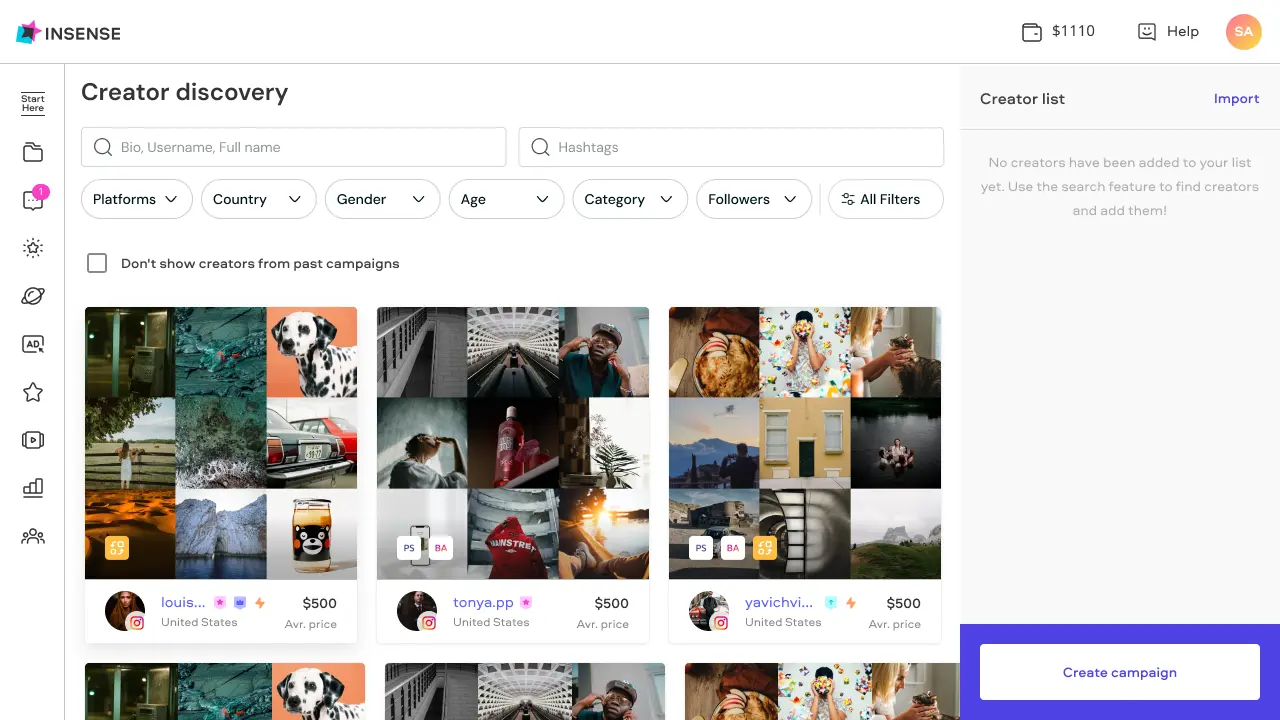Are you a business owner or a marketer looking to grow your business on social media?
If so, you’ve probably heard of influencer marketing, but do you know how much influencers charge? It can be a pretty penny.
But don’t worry. There’s an effective yet affordable option when it comes to influencer marketing, and that’s collaborating with micro-influencers.
In this ultimate guide, we’ll dive into the world of micro-influencers and answer all your burning questions:
- Who are micro-influencers?
- Why work with them?
- How to find them?
And we’ll also cover the factors that impact micro-influencer pricing.
So let’s get started!
Influencers vs. Micro-Influencers
What differentiates micro-influencers from other types of creators?
Broadly speaking, social media influencers are separated into different categories based on their number of followers.
Micro-influencers are social media users with a follower count of around 10,000–100,000.
They create valuable content for their audience in a specific niche.
In the following example, you can see a travel micro-influencer with 27,000 followers on Instagram.

Micro-influencers, as in our example, are above nano-influencers (1,000–10,000 followers) and below macro-influencers (more than 100,000 followers).
The main difference between the types of creators is mainly the social media following.
While nano-influencers are daily users starting to gain traction, micro-influencers have an established audience in a specific market.
Conversely, mega-influencers (more than 1,000,000 subscribers or followers) are usually highly popular and not topic-specific.
While the different types of influencers have pros and cons, working with micro-influencers is ideal for most brands since they’re practical and affordable.
The following section will discuss the benefits of working with them.
Why Work with Micro-Influencers?
Trust is in demand nowadays as 7 out of 10 customers say they would buy products from trustworthy brands.
Celebrity influencers were trusted more in the past. Still, in the last few years, micro-influencers have gained significant momentum since customers can connect with them more meaningfully and authentically.
So it’s no surprise that 90% of marketers say they prefer working with micro-influencers, and in this section, we’ll explain why that happens.
Higher engagement rate
Consider collaborating with micro-influencers if your influencer campaign aims to increase community engagement and brand awareness.
Micro-influencers are the champions when it comes to engagement rates.
While their following isn’t as extensive as other influencers, micro-influencers have the highest engagement rates based on the survey by HypeAuditor.
You may ask, “What’s the big deal with engagement rates?”
The engagement rate measures the interactions between the audience and brands regarding likes, comments, shares, and saves.
A high engagement rate means that your audience is connected with your brand and is more likely to become customers or brand advocates.
More authenticity
Did you know that many mega-influencers have been involved in fraudulent activities?
Authenticity is an element that many brands and marketers usually overlook. And they do so to their detriment.
90% of millennials say brand authenticity is important when deciding what brands they like and support, so it can’t be ignored anymore.
The best way for brands to achieve that authentic connection with their audience is through collaborating with influencers.
Our example from a micro-influencer Instagram post illustrates the difference between Instagram “reality” and actual reality.

Customers are more likely to relate to sponsored posts and recommendations made by natural and honest people.
Also, 84% of consumers are more likely to trust brands if they use user-generated content (UGC) in their campaigns.
Micro-influencers speak their audience's language, like everyday people, to gain more trust.
Super-niche audience
A brand’s products or services are often aimed at specific demographics and niche audiences.
Working with micro-influencers allows brands to aim for that super-niche audience that’s willing to start buying things.
Micro-influencers are well-known to a niche audience that is genuinely connected with them.
The best thing about smaller influencers is that their audience trusts their recommendations, and people follow them for two reasons:
- Micro-influencer content is helpful to them
- They've gained their trust and built an active community
In short, audiences are more willing to buy something if an authoritative source or a niche expert recommends it.
So micro-influencers are also valuable for brands looking to increase their marketing ROI (return on investment) and drive more sales.
Since the reasons to work with micro-influencers are so enticing, let's see what marketing budget you need to have.
How Much Do Micro-Influencers Charge?
As with anything, micro-influencer prices vary.
Before we dive into the details about the pricing, the payment types per influencer post, and what affects them, we’ll start by giving you the average prices based on social media platforms:
- Instagram: $50 – $600
- TikTok: $20 – $500
- Facebook: $100 – $1500
Note: The above values are estimates from surveys and relevant resources like HypeAuditor and Statista. They may not correspond to actual prices, but they’ll give you an overview of the market.
Micro-influencers usually receive performance-based payments, working as affiliates that promote brands’ products or services and getting a percentage of the conversions.
While they generally accept payments in the form of free products or samples, some of them charge per post.
So influencer partnerships with micro-influencers are affordable for businesses of any size and are incredibly effective in affiliate marketing campaigns.
The factors that usually affect influencer compensation are:
- Type of content: The type of content affects the prices since it determines the time and effort an influencer needs to invest. For example, Instagram stories or Reels are easier to produce than YouTube videos.
- Exclusivity: Exclusive partnerships cost more as creators need to sign a non-compete agreement or an exclusivity clause. That means those creators can’t promote the brand’s competitors.
- Number of followers: While following alone isn’t enough as a metric, it remains an important factor in pricing. Creators with more followers cost more because they have a higher reach.
- Platform: Each platform supports different content types and has unique requirements and creative aspects. As seen in the pricing list above, TikTok influencers have different pricing than Facebook.
Other things like engagement rates and the industry or influencer demand can impact influencer pricing too.
We’ve covered micro-influencer pricing and the factors that determine it, but there’s still one question to be answered.
How do you find influencers to work with? You’ll get the answer in the next section.
How to Find the Best Micro-Influencer for Your Brand
We'll focus on the most critical factors to consider when looking for potential micro-influencers here, but if you want more detail, we also have a step-by-step guide.
The following screenshot of Insense, a collaboration platform that helps brands find the best influencers, will help us define what you should look out for when choosing an influencer.

You can use several filters and parameters to find the ideal micro-influencer, such as location, categories, followers, and more.
Through these filters, brands can make sure the influencers align with their needs and values based on aspects such as:
- Niche audience
- Values
- Relevance
These are the most crucial things to evaluate before signing any contract.
And why do we mention these things?
Because you can’t find ideal collaborators if you don’t evaluate them in the first place.
The main issue is that the evaluation process is challenging, requiring time, effort, and experience in most cases.
While there are several ways to find the right micro-influencers, influencer marketing platforms such as Insense are the easiest and headache-free way to narrow your search for the right creator, saving you time and money.
Find Your Ideal Micro-Influencer Now
Don’t miss the opportunity to collaborate with micro-influencers to increase your brand’s reach and engagement. They’re affordable, but they have engaged audiences who trust them.
You don’t have to look for them yourself, however. That can be time-consuming and difficult.
Feel free to book a demo with Insense and get access to over 35,000 vetted influencers for your next marketing campaign.
Frequently Asked Questions (FAQs)
Here are some frequently asked questions to help you learn more about collaborations with micro-influencers.
How do you determine your influencer campaign budget?
To determine your influencer campaign budget, consider the platform, influencer type, campaign length, and micro/macro-influencer charges.
If you’re launching an influencer campaign for the first time, calculate the potential outcome through the influencer’s statistics, such as the average conversion rate, and multiply it by your average order price.
This will help you come up with an estimation of the revenue the influencer campaign can generate.
Then you can offer the optimal payment to the influencer to have a profitable campaign and cut production costs.
How do you plan for and measure a successful influencer campaign?
For a successful influencer campaign, create clear documentation that outlines the following:
- Goals
- Audience
- Budget
- Desired outcomes
- Type of content
Then, track specific metrics or key performance indicators (KPIs), like engagement rates, reach, and conversions, to measure the campaign's success.
Monitor the influencer's performance and adjust accordingly.
What do you need before you contact a prospective influencer?
Before contacting a prospective influencer, define your goals and target audience, set a budget, and know the content you want the influencer to create.
Research potential influencers who fit your audience and brand's values and write a brief outlining campaign scope, content, compensation, and other details.
When you choose the right creators and contact them through social media or email, ask them to provide their media kit with information about previous collaborations.



.avif)


.avif)



